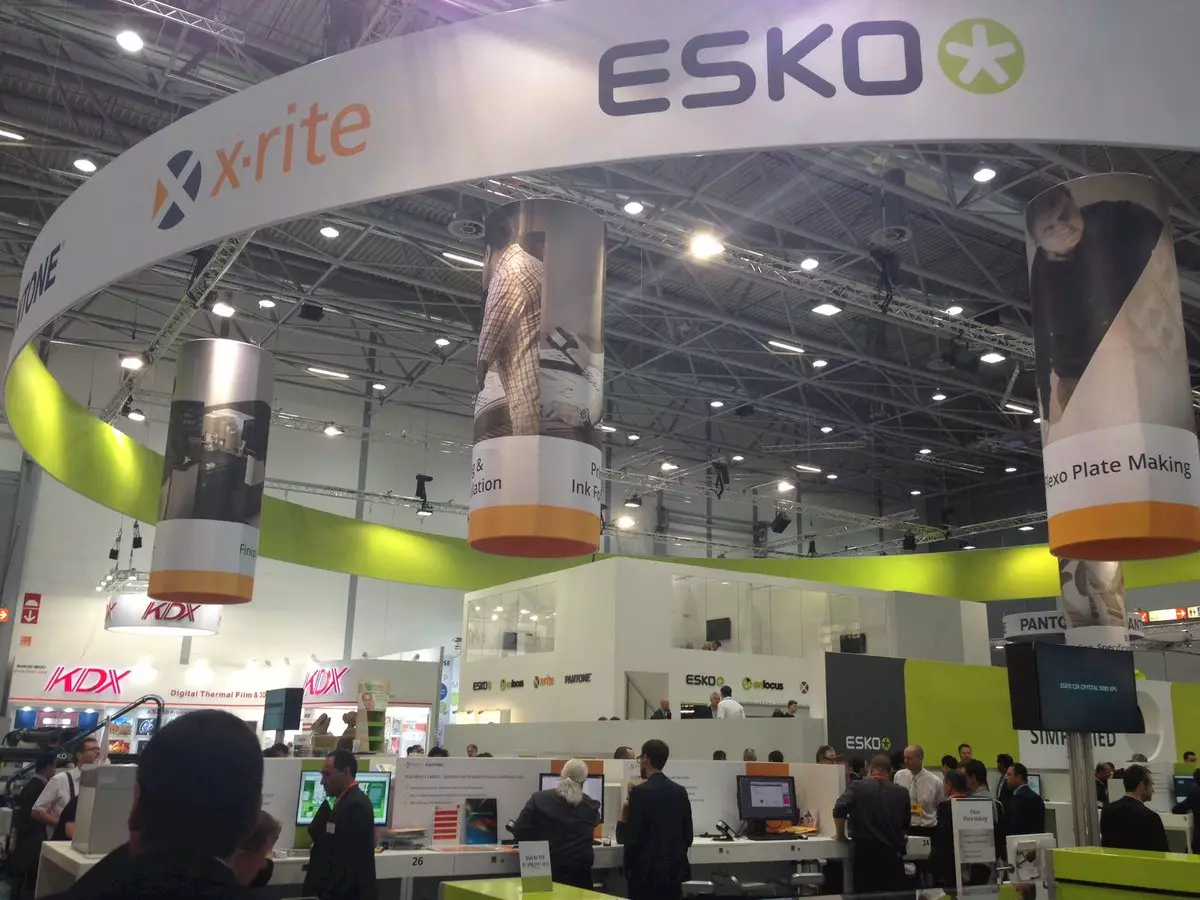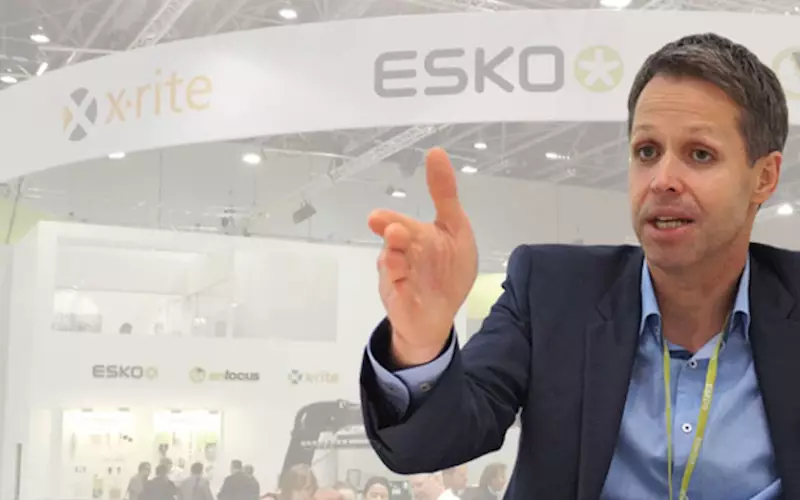A quest to simplify packaging - The Noel D'Cunha Sunday Column
Esko’s theme at Drupa: to make the combination between print and digital as simple as possible.
Esko has modularised software platform, and also announced cooperation with industry leaders aimed to provide best solutions to help packaging master complexities of the supply chain.
In this Sunday Column, Udo Panenka, the president of Esko tells why his company is the best fit within the print packaging process.
01 Jul 2016 | By Noel D'Cunha
PrintWeek India (PWI): What are your five mantras for print at this Drupa?
Udo Panenka (UP): First one is, to support the brands in a way that they can be more successful, sell more of their products with better packaging, signs, display and commercial print.
Second: Better packaging adds complexity to the supply chain. Help the packaging supply chain to master this complexity.
Third: Simplification of the user experience. Make the combination between print and digital as simple as it can be possible with an environment where it is hard to get a qualified operator.
Fourth: Streamline print packaging process – from estimating a job to receiving an order to shipping the finished product – making this process as simple and effective.
And finally, to drive the profitability of the entire packaging supply chain.
PWI: Coming back to Esko, Esko’s platesetter has hit a snag in India… Any reasons?
UP: There are two things – in general terms we needed to improve our sales set-up in India as we have not been able to capture the full potential that’s there in the market. The other thing is that we needed to come up with a renewed offering on the flexo imagers. So here at Drupa we have done that.
At Drupa we have a brand new imager including front and back exposure, leading to two new evolutions – high-quality in the top segment and high consistency of the plate making, which in flexo has been a challenge in the past, and combined it with a simple operation.
PWI: Front and back exposure?
UP: With this technology, we are bringing to the market quality, with which we believe we have set a new benchmark, and also huge improvement in plate consistency as we will have the front and back exposure and imaging together. In the past it was imaging with the front exposure, but we learned that back exposure is also an extremely important aspect.
We have connected the imager and processer to the pre-press arena, simplifying the operations. Now we can put the data directly from the pre-press into platemaking. We now have automated plate handling so you don’t have to take one plate and go through six different devices doing all the complicated things.
We believe this is the kind of disruption in how simple one can prepare a high quality plate.
We believe with our offering at Drupa, we will be able to improve our market share in India dramatically.
 Esko Drupa 2016 stand
Esko Drupa 2016 standPWI: One of the things that you have also done is open your Workflow Suite modules, where one buys what he needs thereby drastically reducing the cost, and then adding modules as and when required. Two things happen, one your Workflow Suite now look affordable and two you can now make your non-customers you customers, particularly in India.
UP: Yes, what you have touched upon is a great point. I would call it the market realisation of our offering. With this what we are doing is offering what you need at this point of time, and build step-by-step as your business grows.
So modularisation is one of the big things in the Esko Software Platform 2016 with which we believe we can really support our customers, especially on the software side.
Esko on a global basis has a big market share, but there are far too many non-customers too. With the modularisation together with new business models like SaaS and Subscriptions, we have got rid of the hurdle, making it easy for a company to start working with Esko. We are continuing to be a company that will support customers in whatever equipment they have. And if our customer understands the value Esko products bring, we would be happy if the next table is a Kongsberg or the next flexo plate setter is a CDI.
PWI: There’s an announcement of EFI and Esko partnership. So, Esko is opening up?
UP: Esko has always been and becoming even more open to really connect the industry. Last year, we came up with the automation engine Connect, which is able to connect all types of web to print, MIS systems, different DFEs, and more and more into the operations part. EFI is one that we have announced. Landa is another one, with even more to come.
EFI and Esko will work under a device management cooperation which will connect their MIS system with their DFEs and building a bridge to support the whole digital press arena from receiving an order, up to fulfilment. This workflow solution together with other Esko tools will enable the supply chain from the brand to the designer to the pre-media house, all the way to the printer converter to leverage the digital print power.
We are open to cooperate with industry leaders in coming up with the best solution for the entire packaging supply chain.
On the stand for the first time at Drupa, we have deep integration of X-Rite measuring devices, PantoneLIVE up to the integration of AVT in the end-to-end quality control and printing process.
PWI: Do you think printers utilise the power of digital press to the full?
UP: I don’t think they do. A digital press can do amazing things for you. Most customers use it only for short runs. They are often missing the point of customisation of the product. It’s only a small per cent of print community who do it.
If you see, Esko software manages the entire packaging pre-press process cycle from managing the content, where we now handle text not as picture but true text, to integration of packaging pre-flighting to quality control stats.
One of solutions we are showcasing at Drupa is the Global Vision’s quality control platform for Esko. We are also offering completely new pre-press editors like the ArtPro+, a new native PDF editor and are coming up with more and more opportunity to connect hardware devices with the pre-press workflow.
PWI: What is the feedback you get, when you visit print companies during your India visits?
UP: India is a fast evolving market – in terms oflife-style and the impact it has onpackaging. It’s always inspiring to be inIndia, because it’s the only way of understanding what our customers want.
I hear people say that printers in countries like India are behind in terms of technology, but I don’t think so. My two hour visit to a customer’s plant leaves me fascinated at the way the business is run. I think the Indian printers face a bit of the same challenges that one sees all over the world at the moment; and these challenges are really about short runs. And there’s a realisation among the brands that better packaging helps them to sell more products. It offers more variations, differentiation and even customisation. All this leads to more jobs on the table for the packagers.
Indian print companies’ customers demand short turnaround times, short lead times, which is not different from what printers across the world face. I am always excited and at times surprised at how sophisticated some of our customers in India and other such countries are.
PWI: What are the technologies which Indian print companies need to take a closer look at?
UP: We hear from our customers that there will be a need to move towards more environmental-friendly technology. This leads especially to flexo gaining popularity. Even in terms of quality, flexo has been able to step-up quite a bit. Some of the platemaking processes, we are showing at Drupa, have been simplified.
From that point of view, we see better adoption of flexo technology, and also see customers experiment with new printing technologies like the digital in some of the areas of applications.
PWI: But the feedback that we get is that at least in the foreseeable future, long runs will reign, and gravure technology is best suited for their operations. So in terms of benefits, what does flexo offer?
UP: As I said the environmental aspect of printing is getting more and more relevant, and flexo is considered a more cleaner technology, and that something that we see will coming more into focus in countries like India, in the near future.

PWI: But then, becoming green is not everything?
UP: True. But besides the environmental aspect, there is a trend towards shorter runs, which will help flexo’s progress. Then there’s the quality requirement with more varying input material.
PWI: When one talks about short-run, digital comes into play and not flexo?
UP: I think my point is: flexo is becoming more attractive for short runs based on simplified platemaking, but when combined with extended gamut printing, you don’t need to worry so much with spot colours. You reduce the changeover times making it again more attractive for short runs.
But we also see that for some of the very short runs, digital is becoming more popular as an option.
PWI: What do you do when you have a mix of technologies – flexo and digital?
UP: Yes, we have seen such kind of evolution because of the short runs and ultra short runs. There is a mix of printing technologies, and that in itself is a bit of a challenge for our customers. It’s easier with a set-up having one printing technology. But if you a set up where you have to drive two different printing technologies, and flexibly use your operation and capacity, than that is an area where we quite clearly see a role which will help run such mixed set-ups and we have different software tools available that help managing printers/converters such set-ups.
PWI: How do you do that?
UP: Esko is pretty big even in the digital print arena, much bigger than some of our customer think. We are supporting leading digital press suppliers with digital front-ends (DFE), managing everything including colour management and are supporting others with workflow automation.
PWI: But most of it is around the workflow?
UP: Yes, the workflow automation which include typical tools within prepress, including content management and connections with the hardware.
PWI: The buzz at Drupa is Industry 4.0, big data, connectivity and internet of thing…
UP: I would really say, its: simplicity and ease of use together with visibility are helping to run presses and other expensive equipment much more efficiently. One of the key aspects of good operation is: using most of the functionality your equipment is offering. The way of interacting is a key driver for us, and that’s where the whole theme of Packaging Simplified comes from.
When we talk to our customers, we realise that they are finding it hard to get qualified operators. The ease of use and simplification are more of key drivers that guide us on the product side.












 See All
See All